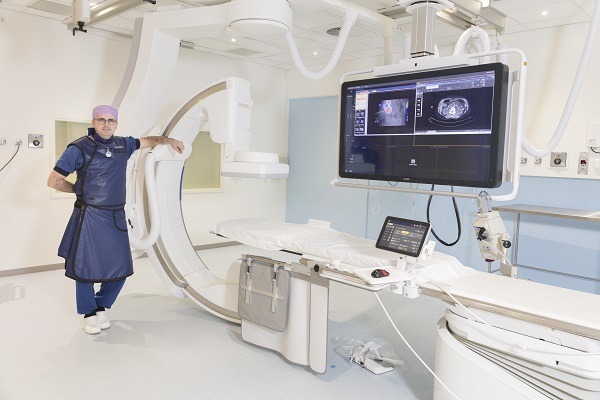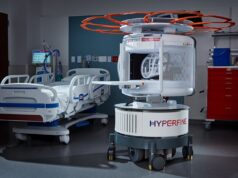
According to early users, the features of the Azurion system—a new imaging system recently released by Philips—make for a “better, safer and faster” workflow, with one centre reporting a 16% improvement in total lab time and 26% improvement in procedure time.
Marco van Strijen (St Antonius Hospital, Nieuwegein, the Netherlands) presented his centre’s first-hand clinical experience with the next-generation imaging system at the Live Interventional Neuroradiology and Neurosurgery Course (LINNC; 13–15 June, Paris, France).
“The Azurion does not stand by itself, there has been over a decade of continuous innovations that have led to the development of the current system. The question is always: how can we improve even further? And the answer this time was to place focus on workflow innovation with the patient experience at the centre and to look at efficiency and integration of workflow in the angio-room,” van Strijen explained.
His centre has been using Azurion now for 10 months. Of the new features available with the next-generation system, van Strijen focused on those that have helped to streamline procedures and improve the efficiency of the workflow. In particular, he mentioned the additions of Procedure Cards, FlexVision Pro, Zero dose positioning, integrated workflow, personal work space and instant parallel working.
According to van Strijen, the introduction of Procedure Cards helps to streamline and standardise the system setup and reduce potential preparation errors. It is now possible to use a single-click procedure setup and these Procedure Cards can be customised per procedure, per physician or per department. Further, hospital-specific checklists and protocols can be added to the Procedure Cards—this makes it easy to consult the checklists and use the protocols available on all the monitors in the room.
Another new feature associated with the Azurion is FlexVision Pro, which allows flexible viewing of the control in the exam room and allows the user to display multiple images from a variety of sources within the angiosuite in a custom set of layouts to support the different types of procedures. Also, with the Procedure Cards, it allows the user to select automatic custom templates with each different procedure. In this way the user can achieve a highly efficient workflow.
Dose reduction technology in neuroangiography and interventional neuroradiology has been a feature provided by the Clarity IQ system which has shown that a 60% reduction of total procedure dose is feasible in neurointervention, while maintaining visualisation of fine detail with no compromise to image quality. Added to that now with Azurion is zero dose positioning where intuitive positioning in the region of interest is possible without using fluoroscopy. “You can move the table and change the table height without using the fluoroscopy peddle and there is also no need for unnecessary magnification,” van Strijen reported.

Further, the integrated workflow that is a feature of Azurion means that the user is able to control everything that is possible with the system from a tableside position, eliminating the need to step outside of the angiosuite or to use the controls in the control room. “In this way, it is feasible to use reference angles, view reports from previous imaging, and to quickly go through a series review. Real-time measurements are feasible and there is easy 3D image acquisition and these are all performed without having to step away from the patient,” van Strijen said. He explained that the functionality of these controls is similar to what physicians are accustomed to using in everyday life with touch screen smart phones and tablets.
“One of my personal favourites is the introduction of the personal work space. By personal workspace I mean that you are now capable of importing different information from a personal source that you can use in your own hospital setting. For instance, you can have a live inventory check for what is available in stock; you can use it for viewing videos or presentations for patient education purposes; you can easily look up difficult protocols or even develop custom applications where you can use, for example, timing protocols to guide you through certain procedures,” van Strijen noted.
Finally, he explained the benefits of the instant parallel working feature. In the past, he said, it was not possible to review the data from a different patient while working in the angiosuite on another patient. Now, with instant parallel working, it is possible to perform these tasks simultaneously and independently during fluoroscopy and exposure. These tasks, for example, could be measurements, picture shifting, reviewing the series of all patients, preparing for the next patient or for reporting, without interrupting the workflow.
Apart from these features of the Azurion system, van Strijen said that his centre looked at other ways to streamline its workflow process beyond the interventional radiology system. “Since we did a complete redesign of our interventional complex, we were also wondering what things we could change to actually achieve the best and most efficient possible workflow in our lab. After an extensive baseline analysis, we had a look at our workflow improvement by changing the way we store our sterile supplies. In both rooms that we use in our hospital we have one large wall with cabinets where all of our basic supplies are stored identically in both rooms so it does not matter anymore if a technician or a nurse is working in one room or another, the layout of the supplies is actually the same.
“On top of this, we store the most commonly used specialised materials in dedicated carts which can be easily restocked from our storage department and then brought to the room and used for specific procedures,” he explained.
The preliminary results for workflow improvement since introducing a completely new system in the angiosuite indicate that the centre was able to improve total lab time by 16%, and improve procedure time by 26%.
“I am glad to conclude that the new Philips Azurion system provides the tools for a better, safer and faster interventional radiology system workflow. This is possible due to the integrated tableside controls, the ability to use parallel working and the integration of the personal work space that are of great benefit to the operator,” van Strijen added.












